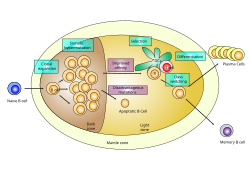Germinal center
This article needs additional citations for verification. (May 2016) |
| Germinal center | |
|---|---|
 Germinal center of a lymph node showing proliferation and development stages of a B cell . | |
| Identifiers | |
| MeSH | D018858 |
| Anatomical terminology | |
Germinal centers or germinal centres (GCs) are sites within secondary lymphoid organs – lymph nodes and the spleen[1] where mature B cells proliferate, differentiate, and mutate their antibody genes (through somatic hypermutation aimed at achieving higher affinity), and switch the class of their antibodies (for example from IgM to IgG) during a normal immune response to an infection. They[clarification needed] develop dynamically after the activation of follicular B cells by T-dependent antigen.
As they undergo rapid and mutative cellular division, B cells of the germinal center are known as centroblasts. Once these B cells have stopped proliferating, they are known as centrocytes, and are subjected to selection by follicular helper T (TFH) cells in the presence of follicular dendritic cells (FDCs). Germinal centers are an important part of the B cell humoral immune response, acting as central factories for the generation of affinity matured B cells specialized in producing improved antibodies that effectively recognize infectious agents, and for the production of durable memory B cells.
Process
- Within lymph nodes, mature peripheral B cells known as follicular (Fo) B cells acquire antigen from FDCs and in turn present it to cognate CD4+ TFH cells at the border that demarcates the T cell zone and B cell follicles (also known as lymphoid follicles). During TFH-B cell conjugation, the B cell receives critical signals to undergo isotype switching (also called immunoglobulin class switching) and to commence monoclonal expansion. During this time they are referred to as centroblasts and make up the dark zone.
- After several rounds of cellular division, the B cells go through somatic hypermutation, a process by which they mutate their antibody-encoding DNA and thus generate a diversity of clones in the germinal center. This involves pseudo-random substitutions biased towards regions encoding the antigen recognition surface of the antibodies the B cells produce. This phenomenon underscores the process of affinity maturation, whereby greater affinity antibodies are produced and selected for after antigen recognition.
- Upon receiving an unidentified stimulus, the maturing B cells (centroblasts) migrate from the dark zone to the light zone and start to express their antibody on the cell surface and at this stage are referred to as centrocytes. The centrocytes are in a state of activated apoptosis and compete for survival signals derived from FDCs and TFH cells. This rescue process, known as germinal center selection, is believed to be dependent on the affinity of their surface antibody to the antigen. Such that, a B cell that has successfully gained mutations that confer a higher affinity surface antibody towards antigen gains a survival advantage over lower affinity B cell clones and those that have gained deleterious mutations. Cyclic re-entry into the dark zone once again as centroblasts allows a chance for otherwise non-selected B cell mutants to gain more mutations in order to improve affinity towards antigen. Interactions with T cells are also believed to prevent the generation of autoreactive germinal center B cells.[2]
- At some unclear stage of their centroblast-centrocyte cycling, maturing B cells receive a final differentiation signal to exit the germinal center as an antibody producing plasma cell which are cells that secrete large quantities of antibody or a memory B cell that can be reactivated in subsequent contacts with the same antigen. Selected B cells may also restart the whole cycle of mutative centroblast division and centrocyte selection. In this way the adaptive immune system, in part through these germinal center reactions, can gradually better recognize antigens over time.
Morphology at different stages
The morphology of GCs is very specific and shows properties which are characteristic for different stages of the reaction.
- In an early state of the reaction a network of FDCs is fully filled with proliferating B cells.
- Later at day 4 of the reaction, GCs show a separation of two zones, the dark and the light zone.[3] The former still contains dominantly proliferating and mutating B cells while the latter one is the area of B cell selection.
- These zones dissolve after 10 days of GC development which ends after about 3 weeks.
Medical relevance
As germinal centers are important structures of the adaptive immune system, their deregulation is implied in many immune diseases, for example rheumatoid arthritis, immunodeficiency and many lymphomas like DLBCL and Burkitt's lymphoma.
See also
References
- ^ Natkunam, Yasodha (1 January 2007). "The Biology of the Germinal Center". ASH Education Program Book. pp. 210–215. doi:10.1182/asheducation-2007.1.210.
- ^ Thorbecke GJ, Amin AR, Tsiagbe VK (1994). "Biology of germinal centres in lymphoid tissue". FASEB Journal. 8 (11): 832–840. PMID 8070632.
- ^ Meyer-Hermann ME (2002). "A Mathematical Model for the Germinal Centre Morphology and Affinity Maturation". J. Theor. Biol. 216 (3): 273–300. arXiv:physics/0203021. doi:10.1006/jtbi.2002.2550. PMID 12183119.
External links
- UIUC Histology Subject 563
- Histology image: 07103loa – Histology Learning System at Boston University - "Lymphoid Tissues and Organs: lymph node, germinal centre"
- Hyperlinked Human Histology
- MedEd at Loyola Histo/practical/lymph/hp12-42.html
